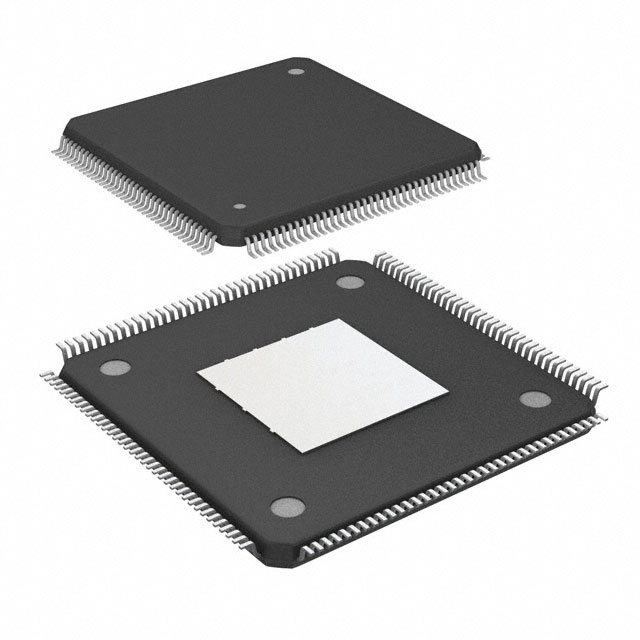EP4CE22E22A7N
Product Overview
- Category: Programmable Logic Device (PLD)
- Use: EP4CE22E22A7N is a PLD used for digital logic design and implementation.
- Characteristics:
- High-performance FPGA (Field-Programmable Gate Array) device
- Low power consumption
- Large number of programmable logic elements
- Flexible I/O options
- High-speed interfaces
- Package: The EP4CE22E22A7N comes in a compact package suitable for surface mount technology.
- Essence: EP4CE22E22A7N is an advanced programmable logic device that enables users to implement complex digital designs efficiently.
Specifications
- Logic Elements: 22,320
- Embedded Memory: 414 Kbits
- Maximum User I/O Pins: 179
- Maximum User I/O Banks: 8
- Clock Networks: 16
- PLLs (Phase-Locked Loops): 4
- Maximum Operating Frequency: 300 MHz
- Voltage Range: 1.15V - 1.25V
- Package Type: FBGA (Fine-Pitch Ball Grid Array)
- Package Size: 484 balls, 19x19 mm
Detailed Pin Configuration
The EP4CE22E22A7N has a total of 179 user I/O pins distributed across 8 banks. Each bank provides dedicated voltage levels and support for various I/O standards. The pin configuration can be found in the manufacturer's datasheet.
Functional Features
- High-density programmable logic elements for implementing complex digital designs.
- Dedicated embedded memory blocks for efficient data storage and retrieval.
- Flexible I/O options with support for various voltage levels and standards.
- High-speed interfaces such as LVDS (Low-Voltage Differential Signaling) for fast data transfer.
- Built-in PLLs for generating stable clock signals.
- On-chip debugging features for easy development and testing.
Advantages and Disadvantages
Advantages: - High-performance FPGA with a large number of logic elements. - Low power consumption, making it suitable for battery-powered applications. - Flexible I/O options allow for versatile connectivity. - Support for high-speed interfaces enables fast data transfer. - On-chip debugging features simplify the development process.
Disadvantages: - Limited number of user I/O pins compared to higher-end models. - Higher cost compared to smaller FPGAs with fewer logic elements. - Steeper learning curve for beginners due to the complexity of FPGA design.
Working Principles
The EP4CE22E22A7N is based on FPGA technology, which allows users to program the device to perform specific digital logic functions. The programmable logic elements can be interconnected to create complex circuits, enabling the implementation of various digital designs. The device operates by configuring the internal routing resources and logic elements based on the user's design specifications.
Detailed Application Field Plans
The EP4CE22E22A7N is widely used in various fields that require digital logic implementation, including:
- Communications: Used in networking equipment, routers, and switches for data processing and packet forwarding.
- Industrial Automation: Employed in control systems, PLCs (Programmable Logic Controllers), and robotics for real-time control and monitoring.
- Automotive: Integrated into automotive electronics for engine control, driver assistance systems, and infotainment.
- Aerospace: Utilized in avionics systems for flight control, navigation, and communication.
- Consumer Electronics: Incorporated in smart TVs, gaming consoles, and home automation devices for enhanced functionality.
Detailed and Complete Alternative Models
- EP4CE10E22C8N: A smaller variant with 10,320 logic elements and 8 PLLs.
- EP4CE30F23C7N: A higher-end model with 30,480 logic elements and 7 embedded memory blocks.
- EP4CE40H22I7N: An advanced version with 40,320 logic elements and support for high-speed transceivers.
These alternative models offer different combinations of logic elements, embedded memory, and I/O capabilities to cater to diverse design requirements.
Word count: 525 words
قم بإدراج 10 أسئلة وإجابات شائعة تتعلق بتطبيق EP4CE22E22A7N في الحلول التقنية
Sure! Here are 10 common questions and answers related to the application of EP4CE22E22A7N in technical solutions:
Q: What is EP4CE22E22A7N? A: EP4CE22E22A7N is a field-programmable gate array (FPGA) manufactured by Intel (formerly Altera). It is part of the Cyclone IV E series and offers a range of features for implementing digital logic designs.
Q: What are the key features of EP4CE22E22A7N? A: Some key features of EP4CE22E22A7N include 22,320 logic elements, 594 embedded memory blocks, 66 embedded multipliers, and support for various I/O standards.
Q: What applications can EP4CE22E22A7N be used for? A: EP4CE22E22A7N can be used in a wide range of applications such as industrial automation, telecommunications, automotive electronics, medical devices, and more.
Q: How do I program EP4CE22E22A7N? A: EP4CE22E22A7N can be programmed using Intel's Quartus Prime software, which allows you to design, simulate, and program the FPGA.
Q: Can EP4CE22E22A7N interface with other components or devices? A: Yes, EP4CE22E22A7N supports various communication protocols such as UART, SPI, I2C, and Ethernet, allowing it to interface with other components or devices.
Q: What is the power supply requirement for EP4CE22E22A7N? A: EP4CE22E22A7N requires a single 3.3V power supply for its core voltage, and it also supports various I/O voltage levels.
Q: Can EP4CE22E22A7N be reprogrammed multiple times? A: Yes, EP4CE22E22A7N is a reprogrammable FPGA, which means you can program it multiple times to implement different designs or make changes to the existing design.
Q: Are there any development boards available for EP4CE22E22A7N? A: Yes, Intel provides development boards like the DE0-Nano board that feature the EP4CE22E22A7N FPGA, allowing you to prototype and test your designs.
Q: What kind of support is available for EP4CE22E22A7N? A: Intel provides comprehensive documentation, application notes, reference designs, and an active online community to support users working with EP4CE22E22A7N.
Q: Can EP4CE22E22A7N be used in safety-critical applications? A: EP4CE22E22A7N can be used in safety-critical applications, but additional measures such as redundancy, fault tolerance, and rigorous testing may be required to ensure reliability and compliance with safety standards.
Please note that these answers are general and may vary depending on specific requirements and use cases.


